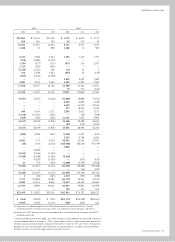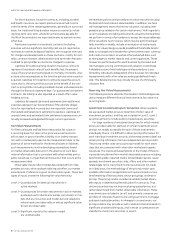GE 2012 Annual Report Download - page 80
Download and view the complete annual report
Please find page 80 of the 2012 GE annual report below. You can navigate through the pages in the report by either clicking on the pages listed below, or by using the keyword search tool below to find specific information within the annual report.78 GE 2012 ANNUAL REPORT
notes to consolidated financial statements
by actual costs incurred in relation to total expected costs. We
routinely update our estimates of future costs for agreements in
process and report any cumulative effects of such adjustments in
current operations. For the Healthcare agreements, we recognize
revenues on a straight-line basis and expense related costs as
incurred. We provide for any loss that we expect to incur on any
of these agreements when that loss is probable.
NBC Universal (NBCU), which we deconsolidated on
January 28, 2011, recorded broadcast and cable television and
Internet advertising sales when advertisements were aired, net
of provision for any viewer shortfalls (make goods). Sales from
theatrical distribution of films were recorded as the films were
exhibited; sales of home videos, net of a return provision, when
the videos were delivered to and available for sale by retailers;
fees from cable/satellite operators when services were provided;
and licensing of film and television programming when the mate-
rial was available for airing.
GECC Revenues from Services (Earned Income)
We use the interest method to recognize income on loans.
Interest on loans includes origination, commitment and other
non-refundable fees related to funding (recorded in earned
income on the interest method). We stop accruing interest at the
earlier of the time at which collection of an account becomes
doubtful or the account becomes 90 days past due, and at that
time, previously recognized interest income that was accrued
but not collected from the borrower is reversed, unless the terms
of the loan agreement permit capitalization of accrued inter-
est to the principal balance. Although we stop accruing interest
in advance of payments, we recognize interest income as cash
is collected when appropriate, provided the amount does not
exceed that which would have been earned at the historical
effective interest rate; otherwise, payments received are applied
to reduce the principal balance of the loan.
We resume accruing interest on nonaccrual, non-restructured
commercial loans only when (a) payments are brought current
according to the loan’s original terms and (b) future payments are
reasonably assured. When we agree to restructured terms with
the borrower, we resume accruing interest only when it is reason-
ably assured that we will recover full contractual payments, and
such loans pass underwriting reviews equivalent to those applied
to new loans. We resume accruing interest on nonaccrual con-
sumer loans when the customer’s account is less than 90 days
past due and collection of such amounts is probable. Interest
accruals on modified consumer loans that are not considered
to be troubled debt restructurings (TDRs) may return to current
status (re-aged) only after receipt of at least three consecu-
tive minimum monthly payments or the equivalent cumulative
amount, subject to a re-aging limitation of once a year, or twice in
a five-year period.
We recognize financing lease income on the interest method
to produce a level yield on funds not yet recovered. Estimated
unguaranteed residual values are based upon management’s
best estimates of the value of the leased asset at the end of the
lease term. We use various sources of data in determining this
estimate, including information obtained from third parties,
which is adjusted for the attributes of the specific asset under
lease. Guarantees of residual values by unrelated third parties are
considered part of minimum lease payments. Significant assump-
tions we use in estimating residual values include estimated net
cash flows over the remaining lease term, anticipated results of
future remarketing, and estimated future component part and
scrap metal prices, discounted at an appropriate rate.
We recognize operating lease income on a straight-line basis
over the terms of underlying leases.
Fees include commitment fees related to loans that we do
not expect to fund and line-of-credit fees. We record these fees
in earned income on a straight-line basis over the period to
which they relate. We record syndication fees in earned income
at the time related services are performed, unless significant
contingencies exist.
Depreciation and Amortization
The cost of GE manufacturing plant and equipment is depreciated
over its estimated economic life. U.S. assets are depreciated using
an accelerated method based on a sum-of-the-years digits formula;
non-U.S. assets are generally depreciated on a straight-line basis.
The cost of GECC equipment leased to others on operating
leases is depreciated on a straight-line basis to estimated residual
value over the lease term or over the estimated economic life of
the equipment.
The cost of GECC acquired real estate investments is depreci-
ated on a straight-line basis to the estimated salvage value over
the expected useful life or the estimated proceeds upon sale
of the investment at the end of the expected holding period if that
approach produces a higher measure of depreciation expense.
The cost of individually significant customer relationships is
amortized in proportion to estimated total related sales; cost
of other intangible assets is generally amortized on a straight-
line basis over the asset’s estimated economic life. We review
long-lived assets for impairment whenever events or changes in
circumstances indicate that the related carrying amounts may
not be recoverable. See Notes 7 and 8.
NBC Universal Film and Television Costs
Prior to our deconsolidation of NBCU in 2011, our policies were to
defer film and television production costs, including direct costs,
production overhead, development costs and interest. We did
not defer costs of exploitation, which principally comprised costs
of film and television program marketing and distribution. We
amortized deferred film and television production costs, as well
as associated participation and residual costs, on an individual
production basis using the ratio of the current period’s gross
revenues to estimated total remaining gross revenues from all
sources; we stated such costs at the lower of amortized cost or
fair value. Estimates of total revenues and costs were based on
anticipated release patterns, public acceptance and historical
results for similar products. We deferred the costs of acquired
broadcast material, including rights to material for use on NBC
Universal’s broadcast and cable/satellite television networks,
at the earlier of acquisition or when the license period began and
the material was available for use. We amortized acquired broad-
cast material and rights when we broadcasted the associated
programs; we stated such costs at the lower of amortized cost or
net realizable value.
























